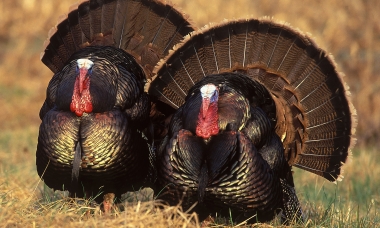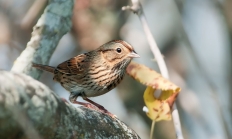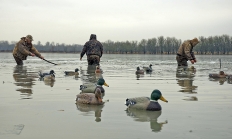
Search myodfw.com
SE WILDLIFE VIEWING December 4, 2025 Harney County This time of year, in Harney County, wildlife viewing is typically targeted towards waterfowl, a variety of shore birds, and raptor species. Look to Malheur National Wildlife Refuge or any of the various reservoirs in the county which should have good water this year. Raptors are present in the district and opportunities abound throughout the county. Look on fence posts, telephone poles, and amongst cliff and talus slopes to see a variety of species that include red-tailed hawks, prairie falcons, ferruginous hawks, golden eagles, and Swainson's hawks. Many passerine species such as
Turkeys make a lot of different sounds, many of which are different in spring and fall. Though most hunters can routinely fill tags by using only two or three sounds, it’s good to know what other sounds turkeys make and why. The hen yelp and variations The most commonly heard sound in the turkey woods is made by the hen, and it’s called a yelp. Toms also yelp, but it’s louder, raspier and often more drawn-out than that of hens. The yelp is usually delivered in a series of one-note tunes. However, yelps can take on various forms. Specifically, there

Pot calls, often called slate calls, are friction-style calls that are easy to use and produce a range of turkey sounds. Parts of a pot call A pot call consists of three parts: a pot, a calling surface and a striker. The pot holds the slate and acts as a sound chamber. There are holes drilled in the bottom for sound to escape. To keep from covering the holes, hold the pot with the tips of your fingers, keeping it away from the palm of your hand. Pot calls can be made to be all-weather, with the right striker. The

SW Fishing Dec 4, 2025 Best bets for weekend fishing: This is good time of year for Chinook anglers to check wild Chinook bag limits for the locations they are planning to fish. Lost Creek Reservoir has had great reports by folks trolling for rainbow trout. Trout stocking Regular stocking will resume February 2026. Trout stocking maps Check out the ODFW fishing and trout stocking maps to find nearby fishing locations, driving directions and descriptions of amenities. Sign up for the latest information on boater access Marine Board's Opportunities and Access Report incorporates information from federal and state agencies, local
Central Fishing December 4, 2025 Best bets for weekend fishing Steelhead anglers have been doing well on the lower Deschutes all the way up to Mecca Flat Fall is great time to fish the Crooked and Metolius Rivers. Anglers report excellent dry fly and nymphing opportunities on Fall River. Anglers report good bank fishing opportunities for trout at Haystack Reservoir Anglers report excellent kokanee fishing at Lake Billy Chinook. Trout stocking Weekly fish stocking will resume in March, 2026. Check out the 2025 stocking schedule. Trout stocking maps Check out the ODFW fishing and trout stocking maps to find nearby

NE Fishing December 4, 2025 Best bets for weekend fishing Trout and whitefish fishing should be good throughout the fall on the Wallowa River. Steelhead fishing has been good on the Grande Ronde and Imnaha Rivers Steelhead fishing is good on the Umatilla River. Trout can still be found on Willow Creek Reservoir. Trout stocking Regular stocking will resume in March 2026. Check out the 2025 stocking schedule. Trout stocking maps Check out the ODFW fishing and trout stocking maps to find nearby fishing locations, driving directions and descriptions of amenities. Announcements If your favorite fishing spot is no longer


SE BIG GAME HUNTING December 4, 2025 Currently open General fall bear, cougar ( Check current harvest numbers), coyote Check regulations for current elk seasons Always check regulations for exact season dates and open areas prior to hunting big game. Announcements, resources 2025 Big Game Hunting Forecast Big game harvest statistics - You'll find links to population, harvest and point summary reports that can help you decide what hunts to apply for next season. Please report elk with hoof disease - If you see elk showing signs of elk hoof disease, including lame or limping elk or elk with damaged
Upon taking an adult salmon, steelhead, legal-size sturgeon or Pacific halibut, the angler must immediately enter the codes for the species caught, ocean port or stream, and the month and day of catch. The information from these tags helps ODFW manage the fisheries and estimate total harvest. Currently nearly 40 percent of anglers use e-tagging. Want to switch from paper to electronic? Login to your account and look under your profile to switch.
NE BIG GAME HUNTING December 4, 2025 Currently open Bear, cougar ( Check current harvest numbers), coyote, elk ( Check regulations for specific dates and units) Announcements, resources 2025 Big Game Hunting Forecast Big game harvest statistics - You'll find links to population, harvest and point summary reports that can help you decide what hunts to apply for next season. Please report elk with hoof disease - If you see elk showing signs of elk hoof disease, including lame or limping elk or elk with damaged, injured, missing or deformed hooves, please report it using this online form. Coyote and
This is the world's smallest "peep" and can usually be picked out by its brownish coloration, dull yellowish legs, and hunched, creeping foraging style. Least can be found in small flocks in Oregon almost year-round. The Least sandpiper feeds on open mud with Western sandpipers but often feeds where some grass, salicornia or other cover is present, avoiding walking in the water as Western often do. It is uncommon to locally abundant statewide in migration, with most birds along the coast and at larger lakes and marshes inland. It is locally common on the coast in winter; smaller numbers winter



Turkey anatomy plays a big part in determining shot placement with a bow. Knowing where vital organs like the heart and lungs are will help you make a clean shot. Sometime getting to the vital organs may mean going through bone. In fact, a shot to the spine will drop a turkey quickly. But turkey bones are very strong, despite being hollow. That’s why many experienced archers prefer shooting a bow with a heavy draw weight, often the same setup they use for deer and elk hunting. Head shots, the most popular turkey shot for shotgun hunters, should be avoided

This small tan-and-gray sparrow with a delicately streaked upper breast is found in summer in wet mountain meadows where its bubbly song can be heard from low shrubs. It winters in brushy lowland areas where it skulks in tall grass and weeds and is usually seen for only a moment. It breeds locally above 3,000 feet in the west Cascades and winters in the valleys west of the cascades. Hear the song of the Lincoln's sparrow Photo by Kelly Colgan-Azar, Flickr

These lizards are found in open desert shrublands, particularly where islands of sand have accumulated around shrubs and are absent where a dense grass understory would inhibit their ability to run. The Long-nosed leopard lizard eats large insects, such as grasshoppers, crickets, and beetles, and also takes small vertebrates, including pocket mice, side-blotched lizards, whiptails, and Western fence lizards. Some plant material (flowers, berries) is eaten when available. Photo by Charlotte Ganskopp


This drab, greenish, diminutive species is similar in appearance to the Hutton's vireo, and sometimes confused with that species in western Oregon. Slighter-billed and smaller than the vireo, this little bundle of energy seems always to be moving as it flicks its wings and hops from twig to twig. The male Ruby-crowned kinglet sports a bright red crown spot, typically visible only when the bird is agitated, and in spring pours fourth a delightful melody, surprising for such a small, drab bird. This species breeds in high elevation forests, primarily east of the Cascade crest, where it is common in

